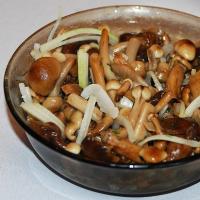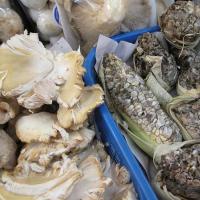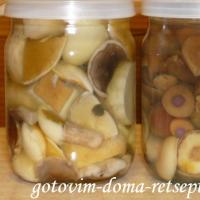spring mushrooms
Departure. They are replaced by others spring mushrooms.
Rosovoplastinnik thyroid (subpricot)
In orchards, ravines, where wild apricot trees grow, the first spring mushrooms appear together - thyroid rosacea(popularly called boletus). This is a tasty mushroom with wide and rare plates. The cap diameter is from one to ten centimeters. The leg is low, dense. The color of the cap and stem is brownish-gray, in young mushrooms it is light pink, in old mushrooms it is pink-brown. The flesh of the fungus is dense, white, with a pleasant smell. The podbrikosovik is delicious salted, fried and marinated.
This mushroom has a deadly poisonous counterpart - yellowish-gray pink. Pay attention to their distinguishing features.
At boletus the cap is funnel-shaped, irregularly shaped, white, light yellow. Cap-colored stem tapering to the ground. The plates are frequent, white, by the time of maturity - yellowish-pink, descending.
Rosovoplastinnik yellowish-gray(poisonous entoloma) has a semicircular, later - convex-outstretched, regular-shaped hat. The leg is white, cylindrical, the plates are pink, adherent.
Spring mushrooms - oyster mushrooms

In a deciduous forest, among oaks, maples, acacias, birches and aspens, oyster mushrooms grow on old stumps and near them, on powdered dry branches. They got such a name due to the fact that they grow, as it were, suspended from a stump on a short bent leg. Oyster mushrooms grow abundantly in places. The color of these mushrooms is varied - white to brown-brown. They have a wide variety of scents. Some have a pleasant mushroom smell, others smell like flour, and others have an unpleasant smell of dampness. The diameter of the cap reaches 30 centimeters, the flesh is white, dense. Mushrooms are usually used freshly cooked in boiled form. They don't have poisonous twins..
Meadow mushrooms - spring mushrooms
Spring mushrooms include mushrooms that appear by mid-May in meadows and forest edges in the form of "witch rings" - meadow mushrooms. This thin agaric mushroom grows in large families, as if compensating the mushroom picker for its small size. And its size is really small. The diameter of the cap is two to four centimeters, in the largest - up to seven centimeters. The thickness of the cap is two to five millimeters, the leg is long - up to ten centimeters, its diameter is slightly thicker than a match.

The color of the cap and legs is the same - light chestnut or yellowish-brown. The plates are whitish, cream or ocher-cream, wide and sparse. The pulp is whitish, has a pleasant mushroom smell, tasteless. Meadow mushrooms are usually boiled, fried and dried. Quite tasty in soups and sauces.
A poisonous mushroom looks like meadow mushrooms hygrocybe conical. The poisonous twin is odorless and has a conical cap, reminiscent of a Vietnamese summer headdress, while the meadow honey agaric never has a pointed cap.
Spring mushrooms - raincoats

After warm May rains, round heads of spring mushrooms turn white in pine and birch forests - raincoats. These mushrooms do not have a cap and legs as such. Their fertile body is homogeneous and has pear-shaped or ball-shaped. The color is pure white or grayish white. There are three types of raincoats:
- golovach,
- spiked raincoat,
- giant fluke.
Golovach and prickly raincoat shaped like a light bulb giant gunship- the shape of a ball. Porkhovik giant and golovach have a white smooth skin, easily separated from the fungus when pressed by hand. Prickly puffball is a relatively small mushroom, its height does not exceed ten centimeters, the surface is scaly. Golovachs reach enormous sizes. Particularly gigantic specimens reached a weight of twelve kilograms. Under favorable conditions, the giant powderfly grows to the size of an average watermelon.
Raincoats are edible only at a young age when their flesh is elastic and white-snow in color. In aging mushrooms, the flesh begins to turn yellow. It is no longer good for food. The dried fungus turns into dry greenish-brown dust.
Raincoats are delicious when served in fried. For their preparation, the skin must be peeled. No need to boil. When frying, the raincoat, unlike other mushrooms, does not secrete mucus and, when fried, looks like deep-fried potatoes, and tastes like young, tender meat.
Raincoats have a dangerous twin - poisonous puffball. Remember their distinguishing features.
The raincoat has a white, slightly yellowish shell, the flesh is white, the smell is subtle, fragrant.
The false raincoat has a grayish-yellowish shell, the flesh is purple-black, the smell is unpleasant.
Champignons - spring mushrooms
In the second half of May, on the soil rich in humus, the first Champignon. In Ukraine they are called stoves. Who has not seen these valuable spring mushrooms in a park, garden or even on the sidewalk under a chestnut, acacia or poplar in a small square of land surrounding a tree, in a stadium or just in a yard near fences and bushes? Champignon grows in large families in meadows and fields, in vegetable gardens and pastures for livestock, in almost any shelterbelt.

The genus of champignons includes eight species, which are distinguished mainly by the place of growth and some external features. All species are united by a pronounced commonality of structure.
The mushroom cap has white or slightly brownish color, convex, smooth or finely scaly. In a young mushroom, it is spherical, connected to the stem with a milky film. As the mushroom grows, the cap of the mushroom increases in diameter, acquires a less spherical shape, and in old mushrooms it is almost flat. In this case, the film is torn and a ring is formed on the leg. The plates of a young champignon are pale pink, with time they become dark pink, light brown and even black in color. The flesh is white, turns pink on the cut, has a strong pleasant smell. These . The stem of the champignon is cylindrical, while that of the young mushroom is dense, thick, and becomes thinner with the growth of the fungus. Champignon is a rather large mushroom. In the meadow, you can often find a mycelium with a diameter of 50 meters, in which there are specimens with a hat of 25–30 or more centimeters.
In many countries of the world, champignons in cooking take pride of place. They can be easily cultivated in kitchen gardens, gardens, cellars. In France, they were grown in quarries as early as the 17th century. Subsequently, mushroom cultivation became widespread in England, the USA, Czechoslovakia, Hungary and other countries. In Russia, mushroom cultivation began at the beginning of the 19th century. Currently, in special greenhouse plants in Moscow, Leningrad, Minsk, Simferopol and other large cities, considerable crops of these fragrant and tasty mushrooms are harvested all year round. Fried champignon is usually used as food. In taste and aroma, it is not inferior to boletus.

Meets poisonous type of champignon, which differs in that its flesh turns yellow at the break and has the smell of carbolic acid.
Many novice mushroom pickers do not collect champignons at all, mistaking them for a pale toadstool. Here are their hallmarks.
Champignon's hat white, slightly brownish, cylindrical stem, pale pink, light brown, dark brown plates, pleasant smell.
At the pale toadstool the hat is white, pale green, the stem is cylindrical, with a tuberous thickening downwards, the plates are white, odorless.
Spring mushrooms - dung beetles
Simultaneously with champignons, small reddish-brown spring mushrooms appear - dung beetles. They grow in well-drained soil, around trees, in vegetable gardens, and even on sidewalks where there is at least a piece of earth left. Grow only in groups, closely pressed hats to each other. At a young age, when they are edible, their caps are similar in shape and size to an elongated egg. Colors are white, gray and orange. By the color of the hat, dung beetles are distinguished - white, gray and shimmery.



